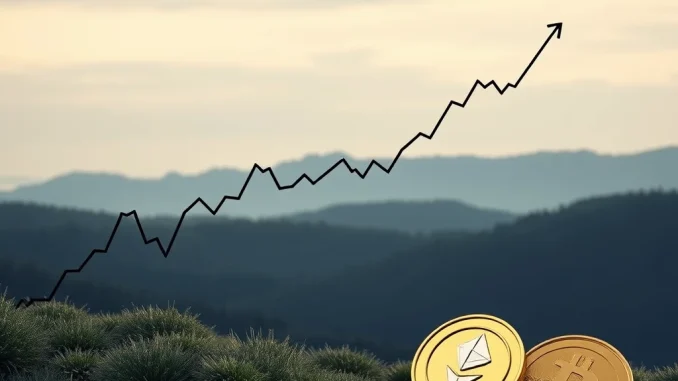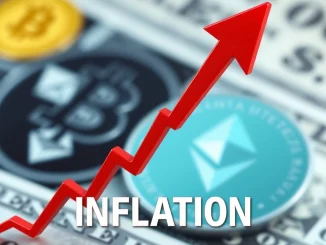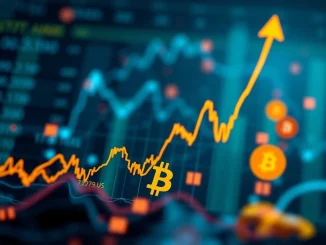
The latest release of key economic data often sends ripples across financial markets, and the cryptocurrency space is no exception. When the US GDP report for the first quarter of 2025 dropped, showing a slight GDP contraction, many in the crypto market took notice. While a contraction might sound concerning, the details reveal a more nuanced picture than the headline number suggests.
Understanding the Latest US GDP Numbers
The U.S. Bureau of Economic Analysis (BEA) released its second estimate for the Q1 2025 Gross Domestic Product, indicating an annual rate of contraction of just 0.2%. This figure, while representing a decline, was actually slightly better than the consensus forecast, which had predicted a 0.3% dip. This marks a significant shift from the robust 2.4% expansion seen in the final quarter of 2024.
What exactly is GDP? It’s the total value of goods and services produced within a country’s borders over a specific period. It’s a primary indicator of economic health. A contraction means the economy shrank, while expansion means it grew.
Here’s a quick comparison:
| Period | GDP Growth Rate (Annualized) | Estimate Type |
|---|---|---|
| Q4 2024 | +2.4% | Final |
| Q1 2025 | -0.2% | Second |
This 0.2% contraction is the second estimate; the final revision is still to come and could see slight adjustments.
Why Does a GDP Contraction Matter for the Crypto Market?
You might wonder, what does something like GDP contraction in the broader US economy have to do with your Bitcoin or Ethereum holdings? Quite a lot, actually. Macroeconomic indicators like GDP influence several factors that directly or indirectly impact the crypto world:
- Monetary Policy: Economic health is a key driver for the Federal Reserve’s decisions on interest rates. A slowing economy could pressure the Fed to consider rate cuts sooner, which can make risk assets like cryptocurrencies more attractive compared to lower-yield traditional investments.
- Investor Sentiment: Strong economic data often correlates with higher investor confidence and a willingness to take on risk (‘risk-on’ environment). Conversely, weak data can lead to a ‘risk-off’ sentiment, where investors move towards safer assets, potentially pulling funds from more volatile markets like crypto.
- Currency Strength: Economic performance affects the strength of the U.S. dollar. A weaker dollar can sometimes make dollar-denominated assets, including cryptocurrencies, appear more attractive to international buyers.
- Inflation/Deflation: GDP trends are linked to inflation. The Fed’s fight against inflation impacts liquidity, which in turn affects asset prices, including crypto.
Navigating the US Economy’s Signals: What Does This Data Suggest?
The Q1 2025 US GDP data paints a picture of an economy that has slowed considerably from the previous quarter’s pace. However, the contraction was marginal and less severe than anticipated, which could be interpreted positively – perhaps a ‘soft landing’ rather than a sharp downturn.
Key takeaways from this specific report:
- The sharp reversal from 2.4% growth highlights a rapid deceleration in economic activity.
- Beating the forecast (a 0.2% contraction is ‘better’ than a 0.3% contraction) suggests underlying resilience might be stronger than feared.
- It puts the spotlight firmly back on the Federal Reserve and the potential timing of interest rate adjustments.
Actionable Insights from Economic Data for Crypto Investors
For those navigating the crypto market, staying informed about crucial economic data like GDP is essential. Here’s how you can use this information:
- Watch the Fed: The marginal contraction, especially if confirmed by the final estimate, increases the likelihood of the Fed considering rate cuts later in the year. Monitor Fed announcements and commentary closely.
- Assess Risk Appetite: Understand that continued signs of economic weakness could lead to short-term volatility as risk-off sentiment waxes and wanes. Be prepared for potential price swings.
- Consider Diversification: While crypto is a distinct asset class, its correlation with traditional finance, particularly tech stocks and overall market sentiment, can increase during significant macro shifts.
- Look Beyond the Headline: Always dig into the details of economic reports. The components of GDP (consumer spending, business investment, government spending, net exports) provide more insight than the single growth number.
Conclusion: Connecting US GDP to Your Crypto Strategy
The Q1 2025 GDP contraction report, while showing a slowdown, offered a slight positive surprise by being less severe than expected. This piece of economic data is more than just a number; it’s a signal about the health of the US economy and a potential predictor of future monetary policy actions. For participants in the crypto market, understanding these macro forces is crucial for making informed decisions in an increasingly interconnected financial world. Keep an eye on the final GDP estimate and how policymakers react, as these will continue to shape the landscape for digital assets.



